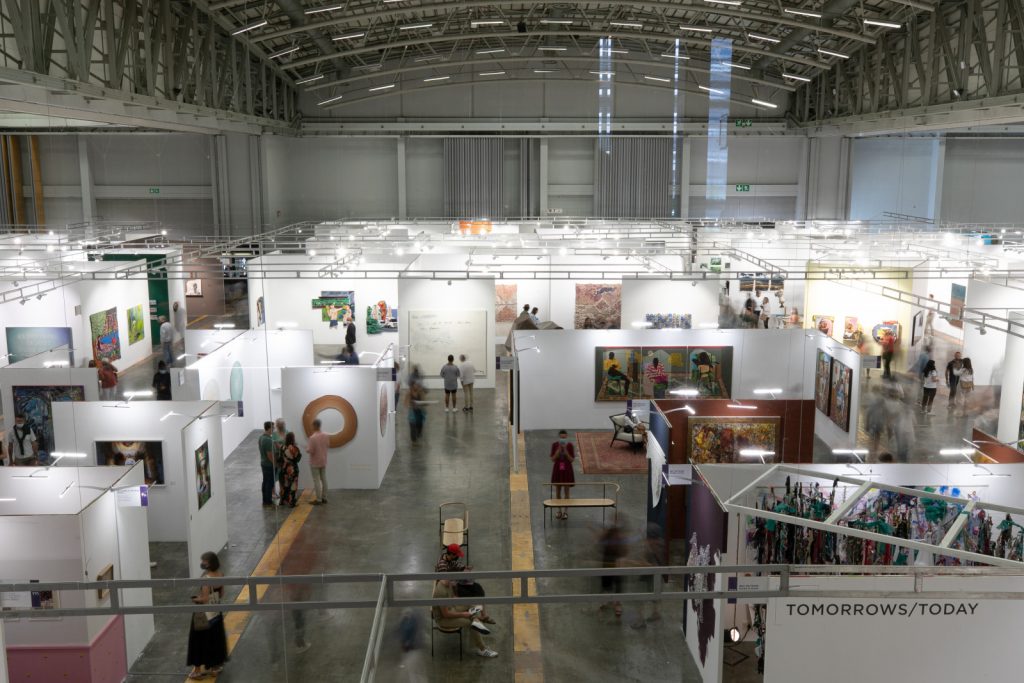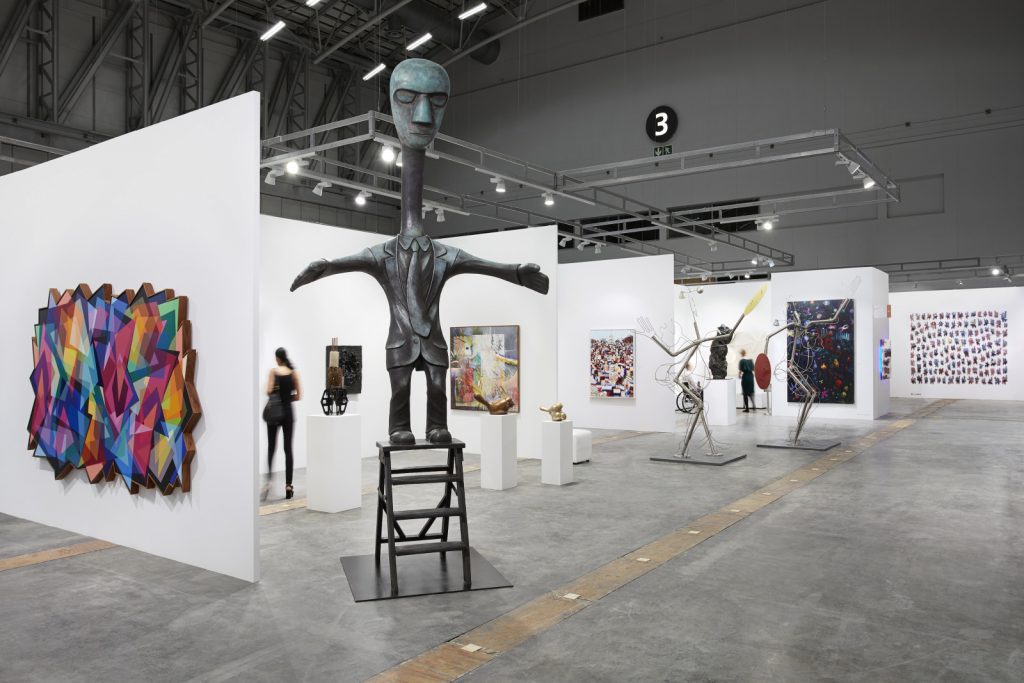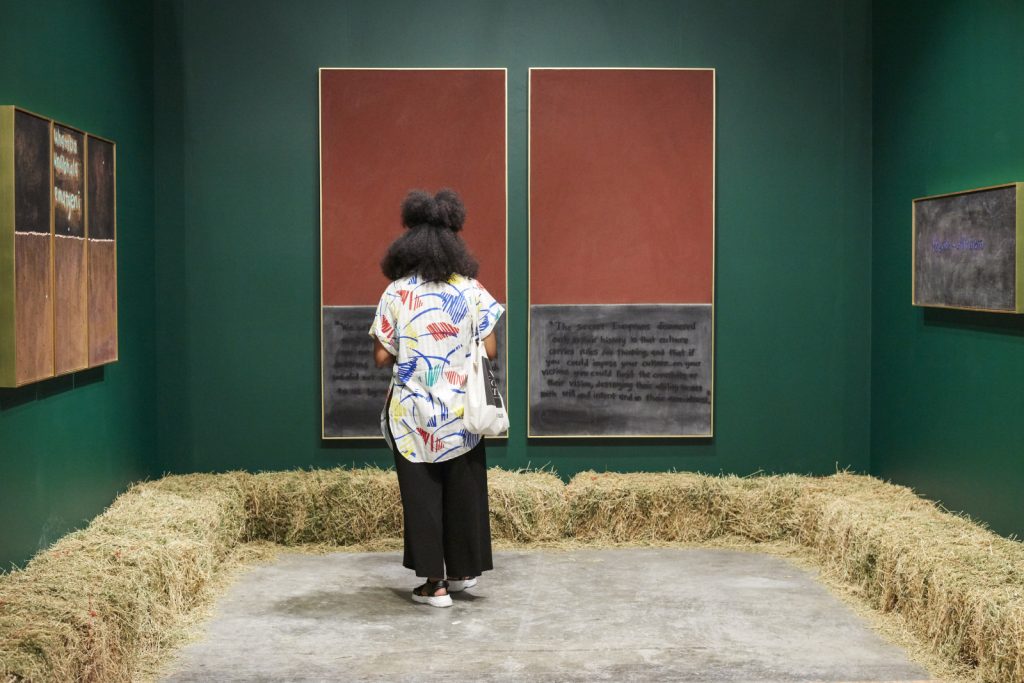Work by Eddy Kamuanga Ilunga, who is from the Democratic Republic of the Congo. (Photos: Güliz Özbek and Stephanie Veldman)
Rarely does the rags-to-riches narrative arc describe the trajectory of an art event, particularly a South African one. Usually, they start in big venues, guided by high ambition, before they shrink to align with reality.
However, in the case of the Investec Cape Town Art Fair (ICTAF), which celebrates its 10th anniversary this year, the reverse occurred. From modest beginnings it has grown into one of the titular city’s most important annual events. Every Joburg art dealer wants in on this fair — some skip the Joburg one to rather invest in making an appearance in this one. If they can get in.
This is the only event in South Africa, or perhaps on the African continent, where you can view a work by Michelangelo Pistoletto, the acclaimed Italian painter, in the same space as a new painting by the Senegalese artist Omar Ba.
It has, as they say, come a long way. This is remarkable given it started out with such a cheesy name. Titled Art for You, the fair was initially guided by the idea of making art accessible, and in keeping with this ethos, it promised visitors none of the works would carry a price tag above R50 000.
 The art of exhibiting: Work on display at last year’s Investec Cape Town Art Fair. (Photos: Stephanie Veldman, Nina Lieska and Güliz Özbek)
The art of exhibiting: Work on display at last year’s Investec Cape Town Art Fair. (Photos: Stephanie Veldman, Nina Lieska and Güliz Özbek)
Not unsurprisingly, this deterred the bigger galleries — Stevenson, Goodman and Everard Read — from participating in the event, held at the Lookout venue at the V&A Waterfront. Only South African galleries participated and art wasn’t the only attraction as it also boasted an exhibition of the culinary arts.
The foodie attraction was no doubt linked to the organisers also being involved in the Good Food & Wine Show. It seems, the owners of the fair — the Italian Fiera Milano company — had slightly more faith in food than art. In a press statement, they indicated that while they were investing R10 million in the Good Food & Wine Show, they would spend R8 million on the Cape Town Art Fair.
Their local team, headed by Louise Cashmore at the time, seemed to have little experience with art fairs, or any art for that matter, yet many were excited by the promise of an art fair for Cape Town, as Joburg had had its fair since 2008.
“It was very small scale but it was exciting. It is incredible to think how far it has come,” comments Marelize van Zyl, senior art specialist at Aspire Art, who at the time was working for Smac Gallery, which took part.
Half of the galleries that participated in the inaugural fair still exist — among them Smac, Barnard, Ebony/Curated, Christopher Moller, World Art, SA Print Gallery and the AVA. Yet the fair itself, as Van Zyl observes, has not only grown and thrived but transmogrified from a sleepy local event to a bona fide international art fair, which draws collectors and galleries from around the world.
You could measure its ascent in economic terms with the highest-priced works in the first edition hovering around the R50 000 mark to Pierneef’s Matlala’s Mountain, Transvaal (1933), which is alleged to have fetched R20 million at last year’s edition.
 Artist Mary Sibande chats to a visitor at the Smac Gallery’s booth at the fair. (Photos: Stephanie Veldman, Nina Lieska and Güliz Özbek)
Artist Mary Sibande chats to a visitor at the Smac Gallery’s booth at the fair. (Photos: Stephanie Veldman, Nina Lieska and Güliz Özbek)
Visitor numbers have also steadily increased. Since the art fair moved to the Cape Town International Convention Centre in 2016, it has gone from attracting 16 000 to 23 000 last year, according to its current director, Laura Vincenti. This growth in audience numbers is significant when you compare it to Art Joburg, formerly the FNB Joburg Art Fair, which doesn’t seem to have been able to break beyond 10 000 visitors, with some arguing it could be significantly less. As the Joburg art fair stagnated, shrunk and lost its international gloss, the ICTAF has blossomed.
What happened in the intervening years, between the cheesy Art For You-cum-foodie event at the Lookout to this international event at a convention centre that attracts big numbers and big spenders, and where you can view works by some of the world’s top international artists?
As is always the case, it is a confluence of conditions and events. One of the pivotal points appears to have been almost immediately after the first edition, when Cashmore, then director of the fair, took advice from several people on the Cape Town art scene, including the late Mark Coetzee, who, in those early days, was already working with German philanthropist and art collector Jochen Zeitz on the concept of a contemporary museum for the city.
Van Zyl recalls a meeting with Coetzee and Cashmore at the Taj hotel in Cape Town to discuss the fair.
“Mark was already planning the Zeitz (Museum of Contemporary Art Africa) and he wanted to activate the Cape Town Art scene at that site; he needed it for his project,” she recalls.
In time, the Zeitz Mocaa and a host of other new private art foundations, which included the Norval Foundation and the A4, would come to boost the ICTAF, as visitors from outside South Africa could look forward to a frenzy of art viewing, beyond the convention centre walls, in quality museum-style exhibitions.
 World class: Last year’s Investec Cape Town Art Fair at the Everard Read Booth. (Photos: Güliz Özbek and Stephanie Veldman)
World class: Last year’s Investec Cape Town Art Fair at the Everard Read Booth. (Photos: Güliz Özbek and Stephanie Veldman)
Cape Town needed a big event to serve as an anchor and catalyst for other events. The city had been starved of something of this magnitude, observed Andrew Lamprecht in an interview in 2014 . He assisted in the curation of the ICTAF in its early years.
“Since the last Spier Contemporary in 2010, Cape Town has lacked a major visual arts event,” he said.
Since the Joburg biennales, there had been a few large-scale art events that attracted international attention to South African art, observed Sue Williamson recently in a film series produced for Investec to celebrate the 10th anniversary.
As a port city that has historically served as a meeting point for visitors from around the world, Cape Town is a natural location for an international event where ideas are exchanged, posits South African artist Athi-Patra Ruga.
If South Africa was going to have an international art fair, ultimately, it was perhaps always going to be in Cape Town, given it is a desirable tourist destination with an abundance of natural beauty, good beaches and is near a wine region.
“Tourists go straight to Cape Town,” admitted Mandla Sibeko, director of the Art Joburg fair, when he became the owner of that fair in 2018. He further suggested Joburg was much harder to market to international visitors, due to crime and other negative perceptions surrounding that city. These weren’t challenges for the fair in Cape Town.
Appealing to tourists has shaped this fair — while the inaugural fair took place in October, the February date became standard, given it is the height of Cape Town’s tourist season. The February date also aligned with other events taking place in the summer, which were attracting Europe’s creative class, such as the Design Indaba and the now-defunct Guild Design Fair. It was around this time that Cape Town was emerging as a “creative” city, earning the World Design Capital title in 2014.
 The Stevenson Gallery’s exhibit. (Photos: Stephanie Veldman, Nina Lieska and Güliz Özbek)
The Stevenson Gallery’s exhibit. (Photos: Stephanie Veldman, Nina Lieska and Güliz Özbek)
Ultimately, perhaps, it was the über-wealthy international art jetsetter who flitted from Art Basel to Frieze London and The Armory Show in New York, whom the fair organisers hoped to attract.
This wasn’t a stretch, given art dealers in Cape Town have for years claimed that their survival is reliant on this transient international population drawn to the city during the summer months.
The first venues for the fair — from the Lookout to the BMW Pavillion and later The Avenue (a venue conveniently located next door to the boujee One&Only hotel) — were all at the V&A Waterfront, a well-known tourist hub, and where Coetzee thought the Zeitz Mocaa needed to be located.
Attracting wealthy art collectors from Europe appears to have also depended on attracting galleries from the continent to participate. This might have given them the comfort of knowing that South African art and the fair itself were at international standards. Galleries from elsewhere did gradually start to participate from around 2014 but it would need a more professional venue to convince them.
For this reason, the 2016 edition has been viewed as a turning point in the fair’s history. It was the first edition at the Cape Town International Convention Centre and while the new director, Matthew Partridge, might not have lasted long, in that year several new ideas were introduced that helped bring it to international standards, such as inviting art curators to present a selection of works from participating galleries.
This would later become the Tomorrows/Today section and remains one of the highlights of the fair — even if it doesn’t quite push any curatorial boundaries or strong ideas. It has created visibility for the work of the artists it showcases, which the award linked to the section further secured.
Usha Seejarim won the award in 2018: “I got a lot of attention, subsequent to that, and I signed up with a gallery. I gained a lot of visibility,” she says.
 A painting by South African artist Helen Sebidi on the exhibition at the Everard Read Booth. (Photos: Güliz Özbek and Stephanie Veldman)
A painting by South African artist Helen Sebidi on the exhibition at the Everard Read Booth. (Photos: Güliz Özbek and Stephanie Veldman)
The changed venue, with an increased footfall, attracted galleries from Europe.
“The interest of exploring the local audience and art scene is for sure the biggest motivation for international galleries to come to Cape Town. The synergy between the
fair and the local institutions has added a major value to this ongoing process,” Vincenti says. The ICTAF has come to position itself as “a vehicle to provide, promote and facilitate sustainable interaction between local and international artists, curators, collectors and galleries”, she adds.
The internationalisation of the ICTAF reached its height in 2019 with only 33% of art galleries (in the main section of the fair) being of South African origin. This was a sharp jump from the previous years, if you consider that, in 2016, 70% of the galleries in the main fair section were of South African origin and almost 80% were African owned.
Naturally, Covid-19 disrupted this upward trend. Anecdotally, when the live fair returned last year, it was once again dominated by South African galleries. This may have been due to travel restrictions and uncertainty.
This did somehow level the playing field for local art dealers who had been excluded from the fair because they had no track record or physical space and didn’t represent suitable artists. This gave birth to the ALT section of the fair, where young, roving or virtual spaces can enjoy a presence.
Yet some galleries have fallen through the gaps — such as the AVA — which due to its non-profit status isn’t able to sell art at the fair, according to its director Mirjam Asmal-Dik.
However, she says that as the foot traffic from the ICTAF spills over into the galleries in the city, they will still feel its benefits.
The Investec Cape Town Art Fair runs from 17 to 19 February. Visit investeccapetownartfair.co.za for more information and tickets.